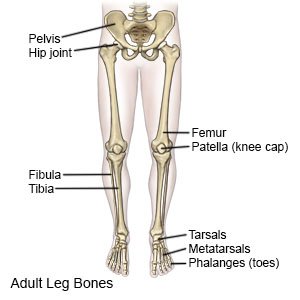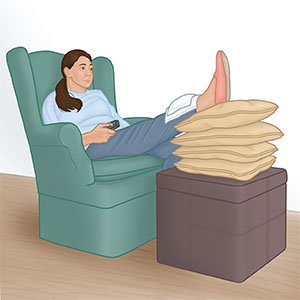Leg Fracture
Medically reviewed by Drugs.com. Last updated on Aug 4, 2025.
AMBULATORY CARE:
A leg fracture
is a break in a bone in your leg.
 |
Common signs and symptoms include the following:
- Pain that worsens when you stand on or move your leg
- Trouble moving your leg
- Leg position or shape that is not normal
- Swelling or bruising
- Weakness or loss of feeling in your leg
Call your local emergency number (911 in the US) if:
- You suddenly feel lightheaded and short of breath.
- You have chest pain when you take a deep breath or cough.
- You cough up blood.
Seek care immediately if:
- Your leg feels warm, tender, and painful. It may look swollen and red.
- The pain in your leg gets worse even after you rest and take medicine.
- Your cast gets wet or damaged.
- Your leg or toes are numb.
- Your leg becomes swollen, cold, or blue.
Call your doctor or bone specialist if:
- You have a fever.
- Your cast or brace is too tight.
- You notice new blood stains or a bad smell coming from under the cast.
- You have new or worsening trouble moving your leg.
- You have questions or concerns about your condition or care.
Treatment
depends on what kind of fracture you have and how bad it is. You may need any of the following:
- A brace, cast, or splint will decrease leg movement and hold the broken bones in place. These devices may help decrease pain and prevent more bone damage.
- Medicines may be used to prevent or treat pain.
- Surgery may be used to put your bones back into the correct position. Wires, pins, plates, or screws may be used to keep the broken pieces lined up correctly and hold them together.
Cast or splint care:
- Ask when it is okay to take a bath or shower. Do not let your cast or splint get wet. Before you bathe, cover the cast or splint with a plastic bag. Tape the bag to your skin above the cast or splint to seal out water. Keep your leg out of the water in case the bag breaks. If a plaster cast gets wet and soft, call your healthcare provider.
- Check the skin around the cast or brace every day. You may put lotion on any red or sore areas.
- Do not push down or lean on the cast or brace.
- Do not put a sharp or pointed object inside the cast to scratch an itch.
Self-care:
- Rest your leg as directed and avoid activities that cause leg pain.
- Apply ice on your leg for 15 to 20 minutes every hour or as directed. Use an ice pack, or put crushed ice in a plastic bag. Cover it with a towel before you apply it. Ice helps prevent tissue damage and decreases swelling and pain.
- Elevate your leg above the level of your heart as often as you can. This will help decrease swelling and pain. Prop your leg on pillows or blankets to keep it elevated comfortably.

- Use crutches or a walker as directed. Crutches will help you walk and take some weight off your leg while it heals.
- Physical therapy may be recommended. A physical therapist teaches you exercises to help improve movement and strength, and to decrease pain.
Follow up with your doctor or bone specialist as directed:
You may need to return to have your splint or cast removed. You may need an x-ray of your leg to check how well the bone has healed. Write down your questions so you remember to ask them during your visits.
© Copyright Merative 2025 Information is for End User's use only and may not be sold, redistributed or otherwise used for commercial purposes.
The above information is an educational aid only. It is not intended as medical advice for individual conditions or treatments. Talk to your doctor, nurse or pharmacist before following any medical regimen to see if it is safe and effective for you.
Further information
Always consult your healthcare provider to ensure the information displayed on this page applies to your personal circumstances.
